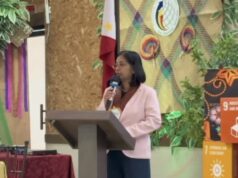CITY OF SAN FERNANDO – A month since typhoons Pedring and Quiel, the toll on rice production in Nueva Ecija, dubbed as the country’s rice granary, has shown.
Nueva Ecija provincial agriculturist Serafin Santos reported recently that the province’s recent rice harvest comprised only 60 percent of what was initially expected.
“The rice crops were hit by the calamity at their vulnerable stages,” he noted.
City and municipal agriculturists estimated that Nueva Ecija lost 300,923.35 metric tons in expected harvest, amounting to P3.63 billion at P12 per kilo.
Records of the provincial agriculture office showed that 188,000 hectares were planted to rice this cropping season in the province. Only about 3,000 hectares had been harvested before the typhoons struck.
Guimba lost P495.1 million when its 14,737 hectares of rice plants suffered 70 percent damage. Other badly hit towns were San Antonio with 6,758 hectares sustaining losses worth P259.5 million, and Zaragoza with 4,015 hectares losing P154.2 million worth of rice crops.
This, even as the National Food Authority in Central Luzon urged local farmers to sell even their damaged rice seeds to the National Food Authority (NFA) in the region.
NFA assistant regional director Gerry Imperial said Pres. Aquino has already authorized his agency to buy such palay seeds in the government’s bid to help farmers displaced by the recent typhoons Pedring and Quiel which flooded vast areas in Central Luzon.
He lamented that while the NFA has been authorized to buy 280,000 bags of damaged rice seeds at the amount of P99 million, no farmer has yet sold such rice to his agency.
Pedring’s total damage on agriculture in rice crops alone was estimated at P8.5 billion in Central Luzon.
“We have remained open, but we have not bought any damaged rice seeds because no one has come,” Imperial said, noting that the NFA in Central Luzon has 58 stations and 12 mobile stores authorized to buy the seeds.
Imperial said NFA will buy for P12 per kilo the seeds estimated to be 40 percent damaged, while those 40 to 60 percent damaged will be bought for P9 pesos per kilo and those 60 to 80 percent damaged will be purchased at P7 per kilo.
He said, however, that NFA is not buying rice seeds exceeding 80 percent damage.
“The damaged seeds we buy will still be dried up and sold, while the irremediable will be ground and marketed as feeds to livestock owners,” Imperial added.
“If the quality of the rice seed is poor, the recovery rate is low. So this really seems a subsidy. What’s important is the farmers retrieving their capital,” he said.
Meanwhile, Imperial also assured the public that rice supply of Central Luzon is sufficient to feed its 9.8 million people for about 74 days.
He said the buffer stock holds 2.5 million bags of rice alone, but noted that with stocks in the hands of traders and those in private warehouses and homes, the region is estimated to have 4.8 million bags.
Department of Agriculture (DA) director for Central Luzon Andrew Villacorta also guaranteed enough rice supply, but admitted that the P8.5 billion damage to rice crops alone in the region was significant.
He echoed Agriculture Sec. Proceso Alcala’s view that despite the rice damage, there would be no need to import more rice to sustain the country’s needs.




